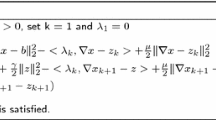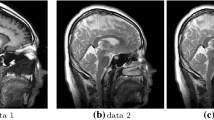Abstract
We present an improved technique for susceptibility artifact correction in echo-planar imaging (EPI), a widely used ultra-fast magnetic resonance imaging (MRI) technique. Our method corrects geometric deformations and intensity modulations present in EPI images. We consider a tailored variational image registration problem incorporating a physical distortion model and aiming at minimizing the distance of two oppositely distorted images subject to invertibility constraints. We derive a novel face-staggered discretization of the variational problem that renders the discretized distance function and constraints separable. Motivated by the presence of a smoothness regularizer, which leads to global coupling, we apply the alternating direction method of multipliers (ADMM) to split the problem into simpler subproblems. We prove the convergence of ADMM for this non-convex optimization problem. We show the superiority of our scheme compared to two state-of-the-art methods both in terms of correction quality and time-to-solution for 13 high-resolution 3D imaging datasets.






Similar content being viewed by others
Explore related subjects
Discover the latest articles, news and stories from top researchers in related subjects.References
Andersson, J.L.R., Skare, S., Ashburner, J.: How to correct susceptibility distortions in spin-echo echo-planar images: application to diffusion tensor imaging. NeuroImage 20(2), 870–888 (2003). doi:10.1016/S1053-8119(03)00336-7
Boyd, S., Parikh, N., Chu, E., Peleato, B., Eckstein, J.: Distributed optimization and statistical learning via the alternating direction method of multipliers. Foundations and trends & #x00AE. Mach. Learn. 3(1), 1–122 (2011). doi:10.1561/2200000016
Chang, H., Fitzpatrick, J.M.: A technique for accurate magnetic-resonance-imaging in the presence of field inhomogeneities. IEEE Trans. Med. Imag. 11(3), 319–329 (1992). doi:10.1109/42.158935
Daga, P., Pendse, T., Modat, M., White, M., Mancini, L., Winston, G.P., McEvoy, A.W., Thornton, J., Yousry, T., Drobnjak, I., Duncan, J.S., Ourselin, S.: Susceptibility artefact correction using dynamic graph cuts: application to neurosurgery. Med. Image Anal. 18(7), 1132–1142 (2014). doi:10.1016/j.media.2014.06.008
Eckstein, J.: Augmented Lagrangian and alternating direction methods for convex optimization: a tutorial and some illustrative computational results. RUTCOR Research Reports, Piscataway, NJ (2012)
Friston, K.J.: Chapter 31—Experimental design and statistical parametric mapping. In: Frackowiak, R.S., Friston, K.J., Frith, C.D., Dolan, R.J., Price, C.J., Zeki, S. , Ashburner, J.T., Penny, W.D. (eds.) Human Brain Function, 2nd edn., pp. 599 – 632. Academic Press, Burlington, MA (2004). doi:10.1016/B978-012264841-0/50033-0
Gabay, D., Mercier, B.: A dual algorithm for the solution of nonlinear variational problems via finite element approximation. Comput. Math. Appl. 2(1), 17–40 (1976). doi:10.1016/0898-1221(76)90003-1
Glowinski, R.: On alternating direction methods of multipliers: a historical perspective. In: Modeling, Simulation and Optimization for Science and Technology, pp. 59–82. Springer, Dordrecht (2014). doi:10.1007/978-94-017-9054-3_4
Golub, G.H., Heath, M., Wahba, G.: Generalized cross-validation as a method for choosing a good ridge parameter. Technometrics 21(2), 215–223 (1979). doi:10.1080/00401706.1979.10489751
Haber, E., Oldenburg, D.: A GCV based method for nonlinear ill-posed problems. Comput. Geosci. 4, 41–63 (2000). doi:10.1023/A:1011599530422
Hansen, P.C.: Rank-deficient and discrete ill-posed problems. SIAM monographs on mathematical modeling and computation. Society for industrial and applied mathematics (SIAM), Philadelphia (1998). doi:10.1137/1.9780898719697
Hansen, P.C., Nagy, J.G., O’Leary, D.P.: Deblurring Images: Matrices, Spectra and Filtering. Matrices, Spectra, and Filtering. Society for industrial and applied mathematics (SIAM), Philadelphia (2006). doi:10.1137/1.9780898718874
Holland, D., Kuperman, J.M., Dale, A.M.: Efficient correction of inhomogeneous static magnetic field-induced distortion in Echo Planar Imaging. NeuroImage 50(1), 175–183 (2010). doi:10.1016/j.neuroimage.2009.11.044
Hong, X., To, X.V., Teh, I., Soh, J.R., Chuang, K.H.: Evaluation of EPI distortion correction methods for quantitative MRI of the brain at high magnetic field. Magn. Reson. Imag. 33(9), 1098–1105 (2015). doi:10.1016/j.mri.2015.06.010
Irfanoglu, M.O., Modi, P., Nayak, A., Hutchinson, E.B., Sarlls, J., Pierpaoli, C.: DR-BUDDI (diffeomorphic registration for blip-up blip-down diffusion imaging) method for correcting echo planar imaging distortions. NeuroImage 106(C), 284–299 (2015). doi:10.1016/j.neuroimage.2014.11.042
Jezzard, P.: Correction of geometric distortion in fMRI data. NeuroImage 62(2), 648–651 (2012). doi:10.1016/j.neuroimage.2011.09.010
Jezzard, P., Balaban, R.S.: Correction for geometric distortion in echo planar images from B0 field variations. Magn. Reson. Med. 34(1), 65–73 (1995). doi:10.1002/mrm.1910340111
Le Bihan, D., Mangin, J.F., Poupon, C., Clark, C.A., Pappata, S., Molko, N., Chabriat, H.: Diffusion tensor imaging: concepts and applications. J. Magn. Reson. Imag. 13(4), 534–546 (2001). doi:10.1002/jmri.1076
Madai, V.I., Martin, S.Z., von Samson-Himmelstjerna, F.C., Herzig, C.X., Mutke, M.A., Wood, C.N., Thamm, T., Zweynert, S., Bauer, M., Hetzer, S., Günther, M., Sobesky, J.: Correction for susceptibility distortions increases the performance of arterial spin labeling in patients with cerebrovascular disease. J. Neuroimag. 26(4), 436–444 (2016). doi:10.1111/jon.12331
Modersitzki, J.: FAIR: Flexible algorithms for image registration, in Fundamentals of Algorithms, vol. 6. Society for Industrial and Applied Mathematics (SIAM), Philadelphia (2009). doi:10.1137/1.9780898718843
de Munck, J.C., Bhagwandien, R., Muller, S.H., Verster, F.C., Van Herk, M.B.: The computation of MR image distortions caused by tissue susceptibility using the boundary element method. IEEE Trans. Med. Imag. 15(5), 620–627 (1996). doi:10.1109/42.538939
Nocedal, J., Wright, S.: Numerical Optimization. Springer Series in Operations Research and Financial Engineering. Springer, New York (2006). doi:10.1007/978-0-387-40065-5
Rockafeller, R.T., Roger, J.B.W.: Variational Analysis, Grundlehren der mathematischen Wissenschaft, vol. 317. Springer, Berlin (1998, 3rd printing 2009). doi:10.1007/978-0-387-40065-5
Ruthotto, L., Kugel, H., Olesch, J., Fischer, B., Modersitzki, J., Burger, M., Wolters, C.H.: Diffeomorphic susceptibility artifact correction of diffusion-weighted magnetic resonance images. Phys. Med. Biol. 57(18), 5715–5731 (2012). doi:10.1088/0031-9155/57/18/5715
Ruthotto, L., Modersitzki, J.: Non-linear image registration. In: Handbook of Mathematical Methods in Imaging, pp. 2005–2051. Springer, New York (2015). doi:10.1007/978-1-4939-0790-8_39
Ruthotto, L., Mohammadi, S., Heck, C., Modersitzki J.W.N.: Hyperelastic susceptibility artifact correction of DTI in SPM. Bildverarbeitung für die Medizin (2013). doi:10.1007/978-3-642-36480-8_60
Skare, S., Andersson, J.L.R.: Correction of MR image distortions induced by metallic objects using a 3D cubic B-spline basis set: application to stereotactic surgical planning. Magn. Reson. Med. 54(1), 169–181 (2005). doi:10.1002/mrm.20528
Smith, S.M., Jenkinson, M., Woolrich, M.W., Beckmann, C.F., Behrens, T.E.J., Johansen-Berg, H., Bannister, P.R., De Luca, M., Drobnjak, I., Flitney, D.E., Niazy, R.K., Saunders, J., Vickers, J., Zhang, Y., De Stefano, N., Brady, J.M., Matthews, P.M.: Advances in functional and structural MR image analysis and implementation as FSL. NeuroImage 23, S208–S219 (2004). doi:10.1016/j.neuroimage.2004.07.051
Stehling, M.K., Turner, R., Mansfield, P.: Echo-planar imaging—magnetic-resonance-imaging in a fraction of a second. Science 254(5028), 43–50 (1991). doi:10.1126/science.1925560
NeuroImage The human connectome project: a data acquisition perspective. 62(4), 2222–2231 (2012). doi:10.1016/j.neuroimage.2012.02.018
Vardal, J., Salo, R.A., Larsson, C., Dale, A.M., Holland, D., Groote, I.R., Bjørnerud, A.: Correction of B0-distortions in echo-planar-imaging-based perfusion-weighted MRI. J. Magn. Reson. Imag. 39(3), 722–728 (2013). doi:10.1002/jmri.24213
Vogel, C.R.: Computational methods for inverse problems. Society for industrial and applied mathematics (SIAM), Philadelphia, PA, Philadelphia (2002). doi:10.1137/1.9780898717570
Wang, Y., Yin, W., Zeng, J.: Global convergence of ADMM in nonconvex nonsmooth optimization (2015). arXiv:1511.06324
Acknowledgements
The 3D data are provided by the Human Connectome Project, WU-Minn Consortium (PIs: David Van Essen and Kamil Ugurbil; 1U54MH091657) funded by the 16 NIH Institutes and Centers that support the NIH Blueprint for Neuroscience Research and by the McDonnell Center for Systems Neuroscience at Washington University. We also like to thank Siawoosh Mohammadi (University Hospital Hamburg Eppendorf, Germany) and Harald Kugel (Department of Clinical Radiology, University Hospital Münster, Germany) for fruitful discussions and helpful suggestions on a first draft of this manuscript. This work is partially supported by the National Science Foundation (NSF) award DMS 1522599.
Author information
Authors and Affiliations
Corresponding author
Additional information
The second author’s work is supported in part by National Science Foundation (NSF) grant DMS 1522599.
Rights and permissions
About this article
Cite this article
Macdonald, J., Ruthotto, L. Improved Susceptibility Artifact Correction of Echo-Planar MRI using the Alternating Direction Method of Multipliers. J Math Imaging Vis 60, 268–282 (2018). https://doi.org/10.1007/s10851-017-0757-x
Received:
Accepted:
Published:
Issue Date:
DOI: https://doi.org/10.1007/s10851-017-0757-x
Keywords
- Numerical Optimization
- Image Registration
- Echo-Planar Imaging (EPI )
- Magnetic Resonance Imaging (MRI )
- Alternating Direction Method of Multipliers (ADMM )




